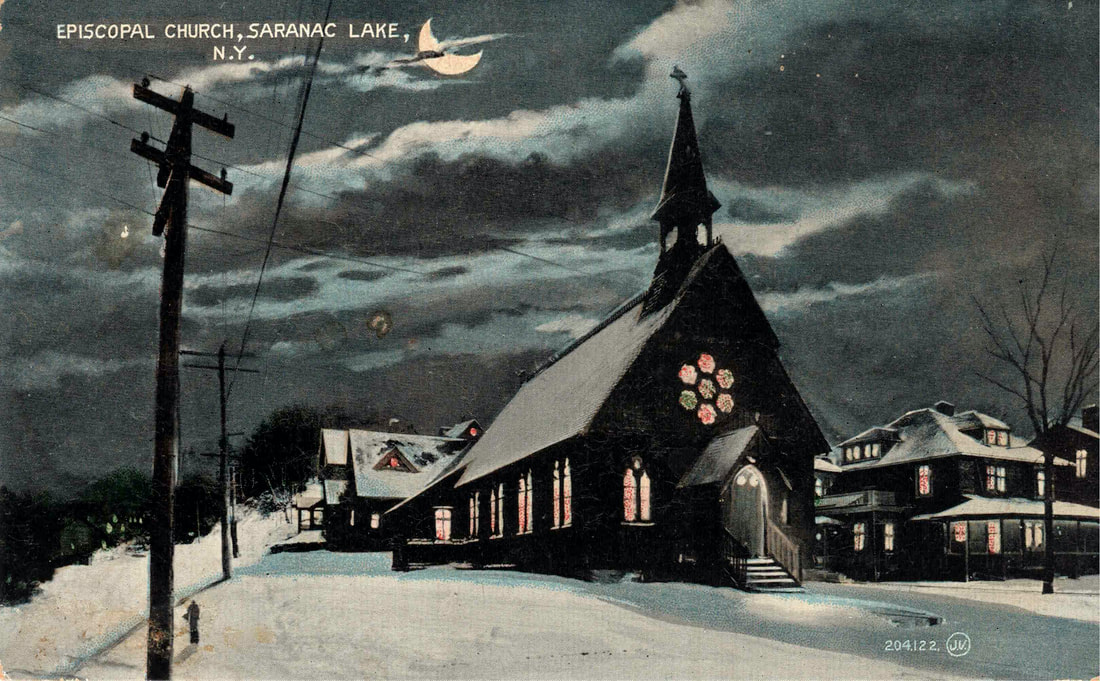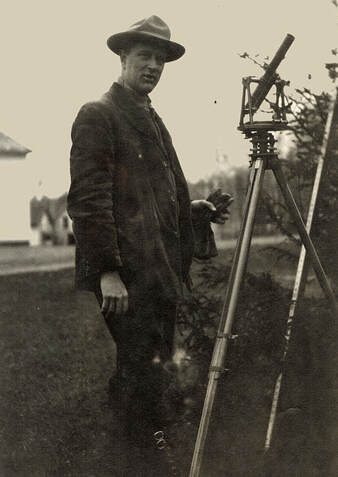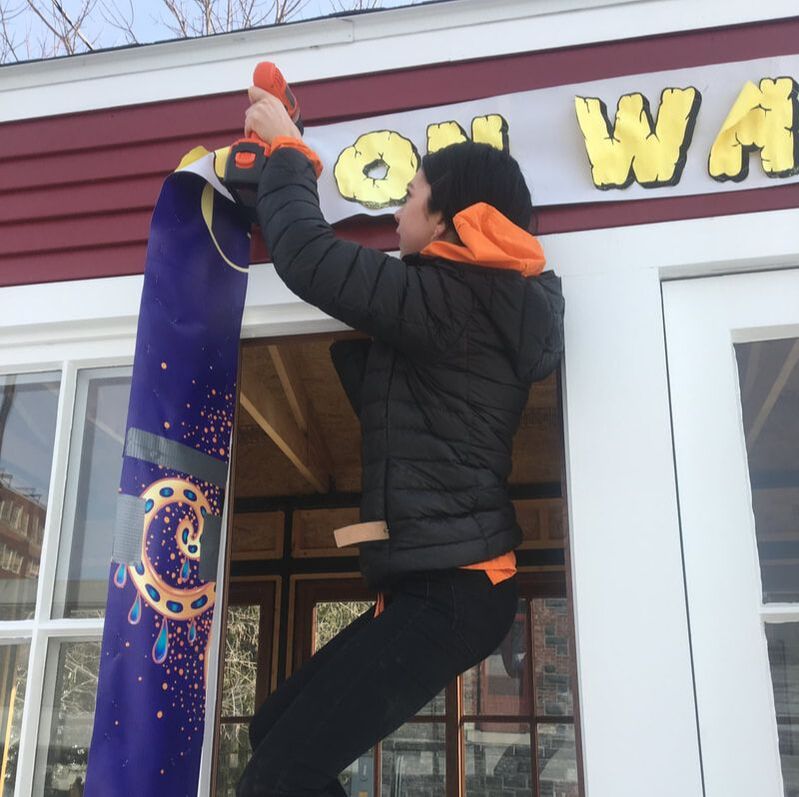1 Comment
This Tuberculosis Thursday marks the 125th birthday of John Baxter Black. Black is shown here in a painting that hangs in the library named for him at the Saranac Laboratory. Black served in several capacities during World War I, including serving in the French Army and driving ambulances. He developed tuberculosis in May of 1918 and was sent to Saranac Lake to cure in July of that year. He cured for five years, and after regaining his health, went to Montreal for a final corrective surgery. Unfortunately Black died from complications from the surgery.
The Black Family, owners of the Ohio Brass Company in Mansfield, Ohio, donated money to expand the Saranac Laboratory and create a research library in his honor. These days, the John Black Room houses rotating exhibits and provides space for lectures and events at the museum. John Black still looks out over the room from this painting today. To learn more about John Baxter Black, visit our wiki. by Amy Catania Seeking some historical perspective on the current pandemic, Historic Saranac Lake recently hosted an imaginary panel discussion at St. John’s in the Wilderness Cemetery. Three generations of Doctors Trudeau shared their thoughts on change and continuity in science and public health. CAST OF CHARACTERS
MODERATOR: In your lifetimes, each of you witnessed major advancements in the scientific understanding and medical treatment of infectious disease. Does it surprise you to see a new virus set the world back on its heels? DOCTOR 2: Indeed, it is a shock. Today’s situation reminds me of the flu that I saw when I served on military base during the Great War. Basic nursing care and sanitary measures were our only weapons. DOCTOR 1: In my time, huge advancements were made in science and medicine, so it is surprising to see the mess we are in with this new virus. 150 years ago, I came to Saranac Lake fighting "consumption," a disease that was killing 1 in 7 people in our country. We had no idea what caused it or how to cure it. Then, in 1882, Dr. Koch discovered the tubercle bacillus under the microscope in Germany. It seemed science would save the world from infectious disease. DOCTOR 2: When the antibiotic treatment for TB was perfected in the 1950s, it was a miracle. Many of my patients who had been sick for years suddenly got out of bed and returned to the living. DOCTOR 3: Thanks to groundbreaking advancements like antibiotics and the polio vaccine, there was great optimism. U.S. Surgeon General William Stewart announced in 1969 that the time had come to “close the book on infectious disease.” DOCTOR 1: I can understand that perspective. “Optimism in Medicine” was the title of my last public speech! MODERATOR: Yet tuberculosis continues as a major public health threat, even now. And here we are with a new virus wreaking havoc around the world. What went wrong? DOCTOR 1: Looking back on my early struggles in the laboratory, I knew then that microbes are tricky little buggers. It is no wonder that they continue to outwit us. DOCTOR 3: In the 1960s, Eastern Europe was experiencing a resurgence of TB. Some doctors from the Soviet Union visited Saranac Lake to learn about our old surgical methods for TB. It drove home for me that science isn’t a straight trajectory. Microorganisms keep evolving. Overused and misused, antibiotics are losing their effectiveness. Some 1.5 million people are expected to die of TB in this new year! Scientific development of new antibiotics is woefully underfunded today. DOCTOR 1: Research dollars flow to where there is money to be made, not necessarily where human health most needs the research. I founded my Saranac Laboratory in 1894 as purely a research laboratory, with no commercial side to it. Soon I realized the difficulty of that model. DOCTOR 3: Still, I have such hope in science! In 1964, I opened the doors of the new Trudeau institute for the first time. I was so proud on that day, and I am thrilled to see Trudeau Institute still with us, carrying out important research. Science holds great promise. Just look at the rapid development of COVID-19 vaccines! DOCTOR 1: Today's vaccines are an achievement that I could have never imagined back in the early days when my microscope was lit by natural light. But it must be a two-pronged approach — science and public health. MODERATOR: What do you think about the state of the public health system today?
DOCTOR 3: Under-resourced systems are straining to care for the sick, administer the vaccines, and prepare for the next disease. The lack of attention to public health is not new. In my time, as we came to rely more on pharmaceuticals, the holistic sanatorium model — buttressing the immune system with a long-term approach to wellness — fell by the wayside. DOCTOR 2: I remember when the last patient left the sanatorium in 1954. It was a sad day for Saranac Lake, but a hopeful day for humanity. We thought then that the magic bullet of pharmaceuticals would simplify patient care and ultimately take the place of many prevention measures. It hasn’t been that easy. DOCTOR 1: It’s been true for a long time — more lives are saved by public health measures than by medical care. Population density, poor sanitation, unventilated spaces, poverty, stress … all of these ills of the modern world contribute to infectious disease. (Yes, the late 1800s were “modern” to us then!) Addressing those conditions was (and is!) essential to improving human health. The world has taken shortcuts around simple public health measures. Coronavirus proves the danger of that approach. DOCTOR 2: With each returning disease, like plague and Cholera, to new ones like HIV, Ebola, SARS, and COVID-19, public funding for emergency response and prevention surges, but then it declines again. MODERATOR: Today's virus isn’t just hitting poor countries hard. Wealthy countries like the U.S. are struggling too. What’s going on? DOCTOR 1: COVID-19 reveals that the same deep inequalities that bred the rise of TB in the 1800s are still with us. DOCTOR 2: It’s a terrible tragedy. I read that on average, each victim of COVID-19 has lost 13 years of life. Blacks and Hispanics are more than twice as likely to die of the disease. But many turn a blind eye. Many people doubt science and medicine and distrust their fellow citizens. Political divisions, exacerbated by the pandemic, are threatening our democratic system. DOCTOR 3: Disease doesn’t have to sow division. There is another path. Look how Saranac Lake came together as a community that cared for the sick with compassion. DOCTOR 1: Empathy was at the heart of our work at Saranac, and the world needs more of it now. I never hired a nurse, orderly, or doctor who did not have that essential quality. I am proud of today’s heroes in medicine and science. Their courageous work during this difficult time reminds me of a favorite phrase, “To cure sometimes, to relieve often, to comfort always.” Sources and Acknowledgements - Epidemics and Society by Frank Snowden, Yale University Press, 2019. - Covid-19 age expectancy statistic: January 2021 "Harper’s Index," Harper's Magazine, Stephen Elledge, Harvard Medical School. - Special thanks for input from Laura Ettinger, Ph.D., Associate Professor of History at Clarkson University and Dr. Tony Holtzman, Emeritus Professor of Pediatrics, Johns Hopkins University. This Tuberculosis Thursday, we're taking the fresh air cure (and having a little fun!). This undated--and slightly edited--photo shows the importance of bundling up when sitting out on your cure porch in the wintertime. Tuberculosis patients would sit out on cure chairs piled high with fur coats, heavy blankets, and even handmade mittens!
To learn more about the other important components of the treatment TB patients received in Saranac Lake, visit our wiki. [Original photograph: Historic Saranac Lake collection, TCR 226] Image of the week: This month marks the 142nd anniversary of the first service held in the St. Luke's Episcopal Church building on the corner of Church and Main Streets. Dr. Edward Livingston Trudeau led the fundraising drive, and then oversaw the construction process for the building that still stands today. Construction began in 1878, and the first service at the Church of St. Luke, the Beloved Physician was held January 12, 1879.
Learn more on our wiki. [Historic Saranac Lake Collection, courtesy of of Lucy Jones Berk.]
This week we are saying a fond farewell to Kayt Gochenaur, our Oral History Coordinator and Cure Porch on Wheels Extraordinaire, as she moves on to an exciting new position! Kayt will be spreading her wings and joining the world of finance, working down the street at The Campbell Group/Ameriprise Financial. Kayt has done a great job coordinating the Oral History Project and the CPOW for the past three years. She has added so much to our team here at HSL, and always approaches every project with enthusiasm, inquisitiveness, and a killer sense of style. We will miss you, Kayt!
The Cure Porch on Wheels will keep rolling on, and we look forward to sharing news about exciting programs and events to come! Images: Kayt interviewing Airlie Lennon in the Saranac Laboratory Museum, 2018; conducting "man on the street" interviews to document the Covid-19 pandemic in Saranac Lake, 2020; introducing the completed Cure Porch on Wheels to supporters, 2019; getting hands-on after Winter Carnival, 2019; and attending design meetings in the early stages of creating the CPOW, 2018. In honor of January being "National Hobby Month," this Tuberculosis Thursday we're sharing this photo of Helen Ratner (and friends) working on her knitting at Trudeau Sanatorium. Many of the patients took up knitting and other hobbies as a way to pass the time while curing.
Patients could also learn knitting and many, many other arts and crafts skills at the Scholfield Memorial Workshop and the Study and Craft Guild. Many patients sold their works, and some even turned their skills into lifelong careers! Learn more about the use of hobbies and occupational therapy in the TB industry in the virtual version of our Art of the Cure exhibit. [Photograph of Helen Ratner and friends at Trudeau Sanatorium, c.1923. Historic Saranac Lake Collection, TCR 410. Courtesy of Mary Tim Baggott.] Happy New Year from all of us at Historic Saranac Lake! We appreciate your support in this unusual year, and look forward to sharing even more of our unique local history with you in 2021!
[New Year's photo card from Dr. and Mrs. Trudeau, undated. Historic Saranac Lake Collection, TCR 337. Courtesy of Karen Lewis.] |
About us
Stay up to date on all the news and happenings from Historic Saranac Lake at the Saranac Laboratory Museum! Archives
August 2022
Categories
All
|
Historic Saranac Lake at the Saranac Laboratory Museum
89 Church Street, Suite 2, Saranac Lake, New York 12983
(518) 891-4606 - [email protected]
89 Church Street, Suite 2, Saranac Lake, New York 12983
(518) 891-4606 - [email protected]

Historic Saranac Lake is funded in part by the New York State Council on the Arts with the support of the Office of the Governor and the New York State Legislature,
and an Essex County Arts Council Cultural Assistance Program Grant supported by the Essex County Board of Supervisors.
and an Essex County Arts Council Cultural Assistance Program Grant supported by the Essex County Board of Supervisors.
© 2023 Historic Saranac Lake. All Rights Reserved. Historic photographs from Historic Saranac Lake Collection, unless otherwise noted. Copy and reuse restrictions apply.



















 RSS Feed
RSS Feed